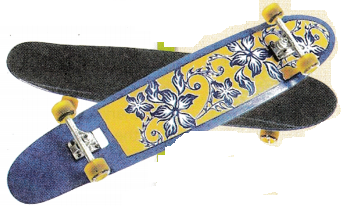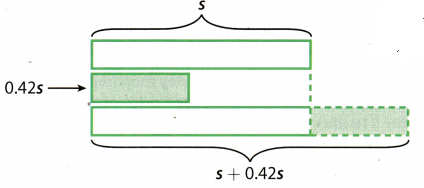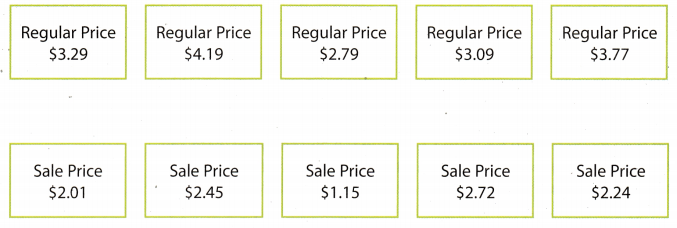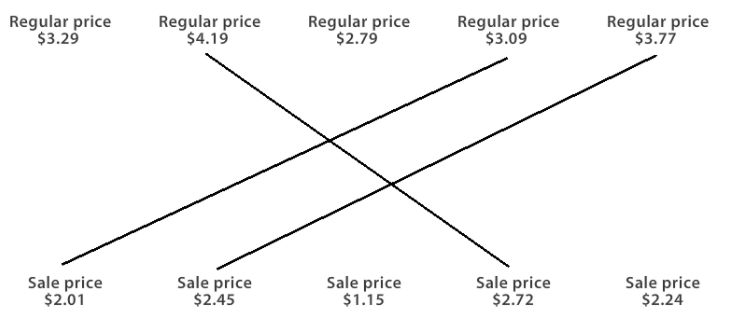Refer to our Texas Go Math Grade 7 Answer Key Pdf to score good marks in the exams. Test yourself by practicing the problems from Texas Go Math Grade 7 Lesson 3.3 Answer Key Markup and Markdown.
Texas Go Math Grade 7 Lesson 3.3 Answer Key Markup and Markdown
Example 1
To make a profit, stores mark up the prices on the items they sell. A sports store buys skateboards from a supplier for s dollars. What is the retail price for skateboards that the manager buys for $35 and $56 after a 42% markup?

Step 1: Use a bar model.
Draw a bar for the cost of the skateboard s.
Then draw a bar that shows the markup: 42% of s, or 0.42s.

These bars together represent the cost plus the markup, s + 0.42s.
Step 2: Retail price Original cost + Markup
= s + 0.42s
= 1s + 0.42s
= 1.42s
Step 3: Use the expression to find the retail price of each skateboard.
s = $35 → Retail price = 1.42($35) = $49.70
s = $56 → Retail price = 1.42($56) = $79.52
Reflect
Question 1.
What If? The markup is changed to 34%; how does the expression for the retail price change?
Answer:
The expression for the retail price now looks like this:
Retail price = Original cost + Markup
= s + 0.34s
= 1 s + 0.34s
= 1.34s
Retail price = 1.34s
Your Turn
Question 2.
Rick buys remote control cars to resell. He applies a markup of 10%.
a. Write two expressions that represent the retail price of the cars.
Answer:
Retail price = Original cost + Markup
= s + 0.10s
= 1.10s (= 110% × s)
b. If Rick buys a remote control car for $28.00, what is his selling price?
Answer:
Using the expression above, calculate the selling price.
s = $28 ⇒ Retail price 1.10 × $28 = $30.8
Question 3.
An exclusive clothing boutique triples the price of the items it purchases for resale.
a. What is the boutique’s markup percent? ____________________________
Answer:
Let p be the markup and s the original price. The boutique triples its original price, Thus, the end price is 3s
s + p × s = 3s
1 + p = 3
p = 2 (Divide by s)
p = 200%
b. Write two expressions that represent the retail price of the clothes.
Answer:
Retail price = Original cost + Markup
= s + 2s
= 3s (= 300% × s)
Example 2
A discount store marks down all of its holiday merchandise by 20% off the regular selling price. Find the discounted price of decorations that regularly sell for $16 and $23.
Step 1: Use a bar model.
Draw a bar for the regular price p.
Then draw a bar that shows the discount: 20% of p, or 0.2p.

The difference between these two bars represents the price minus the discount, p – 0.2p.
Step 2: Sale price = Original price – Markdown
= p – 0.2p
= 1 p – 0.2p
= 0.8p
Step 3: Use the expression to find the sale price of each decoration.
p = $16 → Retail price = 0.8($16) = $12.80
p = $23 → Retail price = 0.8($23) = $18.40
Reflect
Question 4.
Conjecture Compare the single term expression for retail price after a markup from Example 1 and the single term expression for sale price after a markdown from Example 2. What do you notice about the coefficients in the two expressions?
Answer:
The first coefficient is greater than 1, and the second coefficient is lesser that 1.
Your Turn
Question 5.
A bicycle shop marks down each bicycle’s selling price b by 24% for a holiday sale.
a. Draw a bar model to represent the problem.
Answer:
Picture below

b. What is a single term expression for the sale price?
Answer:
Sale price = Original price – Markdown
= b – 0.24b
= 0.76b
Question 6.
Jane sells pillows. For a sale, she marks them down 5%.
a. Write two expressions that represent the sale price of the pillows.
Answer:
Retail price = Original cost – Markdown
= p – 0.05p
= 0.95p(= 95% × s)
b. If the original price of a pillow is $15.00, what ¡s the sale price?
Answer:
Using the expression above, calculate the selling price.
s = $15 ⇒ Retail price = 0.95 × $15 = $14.25
Texas Go Math Grade 7 Lesson 3.3 Guided Practice Answer Key
Question 1.
Dana buys dress shirts from a clothing manufacturer for s dollars each, and then sells the dress shirts in her retail clothing store at a 35% markup. (Example 1)
a. Write the markup as a decimal. __________________________________
Answer:
Markup = 35% = 0.35
b. Write an expression for the retail price of the dress shirt. _____________
Answer:
Retail price = Original cost + Markup
= s + 0.35s
= 1.35s
c. What is the retail price of a dress shirt that Dana purchased for $32.00?
Answer:
Retail price = 1.35s = 1.35 × $32 = $43.2
d. How much was added to the original price of the dress shirt? ____________
Answer:
Added price = New price – Original price
= $43.2 $32
= $11.2
List the markup and retail price of each item. Round to two decimal places when necessary. (Example 1).

Answer:
2.
Markup = 15% = 0.15
Retail price = Original cost + Markup
= h + 0.15h
= 1.15h
= 1.15 × $18
= $20.7
3.
Markup = 42% = 0.42
Retail price = Original cost + Markup
= b + 0.42b
= 1.42b
= 1.42 × $22.50
= $31.95
4.
Markup = 75% = 0.75
Retail price = Original cost + Markup
= s + 0.75s
= 1.75s
= 1.75 × $33.75
≈ $59.06
5.
Markup = 33% = 0.33
Retail price = Original cost + Markup
= s + 0.33s
= 1.33s
= 1.33 × $74.99
≈ $99.74
6.
Markup = 100% = 1
Retail price = Original cost + Markup
= c + 1 c
= 2c
= 2 × $48.60
= $97.20
7.
Markup = 125% = 1.25
Retail price = Original cost + Markup
= p + 1.25p
= 2.25p
= 2.25 × $185
= $416.25
Find the sale price of each item. Round to two decimal places when necessary. (Example 2)
Question 8.
Original price: $45.00; Markdown: 22%
Answer:
Markdown = 22% = 0.22
Sale price = Original cost Iarkdown
= x – 0.22x
= 0.78x
= 0.78 × $45
= $35.1
Question 9.
Original price: $89.00; Markdown: 33
Answer:
Markdown = 33% = 0.33
Sale price = Original cost – Markdown
= x – 0.33x
= 0.67x
= 0.67 × $89
= $59.63
Question 10.
Original price: $23.99; Markdown: 44%
Answer:
Markdown = 44% = 0.44
Sale price = Original cost – Markdown
= x – 0.44x
= 0.56x
= 0.56 × $23.99
≈ $13.43
Question 11.
Original price: $279.99, Markdown: 75%
Answer:
riarkdown = 75% = 0.75
Sale price = Original cost – Markdown
= x – 0.75x
= 0.25x
= 0.25 × $279.99
≈ $70
Essential Question Check: In
Question 12.
How can you determine the sale price if you are given the regular price and the percent of markdown?
Answer:
First, write markdown as a decimal. Then, write the expression for the Sale price by subtracting markdown multiplied by the original price from the original price.
Texas Go Math Grade 7 Lesson 3.3 Independent Practice Answer Key
Question 13.
A bookstore manager marks down the price of older hardcover books, which originally sell for b dollars, by 46%.
a. Write the markdown as a decimal. _______________________________
Answer:
Markdown = 46% = 0.46
b. Write an expression for the sale price of the hardcover book. ______________
Answer:
Sale price = Original cost – Markdown
= b – 0.46b
= 0.54b
c. What is the sale price of a hardcover book for which the original retail price was $29.00? _______________________________
Answer:
Sale price = 0.54b
= 0.54 × $29
= $15.66
d. If you buy the book in part c, how much do you save by paying the sale price? ______________
Answer:
Money saved = Original price – Sale price
= $29 – $15.66
= $13.34
Question 14.
Raquela’s coworker made price tags for several items that are to be marked down by 35%. Match each Regular Price to the correct Sale Price, if possible. Not all sales tags match an item.

Answer:
Markdown = 35% = 0.35
Sale price = Regular price – Markdown
= x – 0.35x
= 0.65x
Now, calcuLate each price separately and match.
Sale price = 0.65x
= 0.65 × $3.29
≈ $2.14
Sale price = 0.65x
= 0.65 × $4.19
= $2.72
Sale price = 0.65x
= 0.65 × $2.79
≈ $1.81
Sale price = 0.65x
= 0.65 × $3.09
≈ $2.01
Sale price = 0.65x
= 0.65 × $3.77
≈ $2.45

Question 15.
Communicate Mathematical Ideas For each situation, give an example that includes the original price and final price after markup or markdown.
Answer:
We are going to rise the same Original price for all 3 subtasks.
Original price = x = $100
a. A markdown that is greater than 99% but less than 100%
Answer:
Markdown = 99.5% = 0.995
Sale price = x – 0.995x
= 0.005%
= 0.005 × $100
= $0.5
b. A markdown that is less than 1%
Answer:
Markdown = 0.5% = 0.005
Sale price = x – 0.005x
= 0.995x
= 0.995 × $100 = $99.5
c. A markup that is more than 200%
Answer:
Markdown = 250% = 2.5
Sale price = x + 2.5x
= 3.5x
= 3.5 × $100 = $350
Question 16.
Represent Real-World Problems Harold works at a men’s clothing store, which marks up its retail clothing by 27%. The store purchases pants for $74.00, suit jackets for $325.00, and dress shirts for $48.00. How much will Harold charge a customer for two pairs of pants, three dress shirts, and a suit jacket?
Answer:
First, get the expression for Retail, price.
Retail price = Original cost + Markup
= x + 27%x
= x + 0.27x
= 1.27x
Using the expression for RetaiL price, calculate the prices of given items.
Pants Retail price = 1.27 × .874
= $93.98
Suit jackets Retail price = 1.27 × $325
= $412.75
Dress shirts Retail price = 1.27 × $48
= $60.96
Calculate the bill of the customer using the obtained Retail prices.
2 pairs of pants + 3 dress shirts + 1 suit jacket = 2 × $93.98 + 3 × $60.96 + $412.75
= $187.96 + $182.88 + $412.75
= $783.59
Question 17.
Analyze Relationships Your family needs a set of 4 tires. Which of the following deals would you prefer? Explain.
(I) Buy 3, get one free (II) 20% off (III) \(\frac{1}{4}\) off
Answer:
(I)
If you buy 3 and get 1 free, you pay \(\frac{3}{4}\) of the price, that means you get \(\frac{1}{4}\) discount
(II)
20% = 0.2 = \(\frac{1}{5}\)
It is obvious that options (I) and (III) are the same, and they are born preferrable over option (II).
H.O.T. Focus On Higher Order Thinking
Question 18.
Critique Reasoning Margo purchases bulk teas from a warehouse and marks up those prices by 20% for retail sale. When teas go unsold for more than two months, Margo marks down the retail price by 20%. She says that she is breaking even, that is, she is getting the same price for the tea that she paid for it. Is she correct? Explain.
Answer:
No, she is not correct. When she is applying markup of 20%, the Retail price is 120% of the original price. Let x be the original price, Retail price = 1.2x.
Now, calculate the Retail price marked down by 20%. Let r be the Retail price and in the marked down price.
m = r – 0.2r
= 0.8r
= 0.8 × 1.2x
= 0.96x
As you can see, she is not breaking even, she is losing 4% of income on tea that goes unsold for 2 months.
Question 19.
Problem Solving Grady marks down some $2.49 pens to $1.99 for a week and then marks them back up to $2.49. Find the percent of increase and the percent of decrease to the nearest tenth. Are the percents of change the same for both price changes? If not, which is a greater change?
Answer:
First, find the markdown by finding the Amount of change, and dividing it by the Original cost.
Amount of change = $2.49 – $1.99
= $0.5
Markdown = \(\frac{\$ 0.5}{\$ 2.49}\)
≈ 0.201
≈ 20.1%
Now, find the markup by dividing the amount of change (which is the same) by the Marked down cost
Markup = \(\frac{\$ 0.5}{\$ 1.99}\)
≈ 0.251
≈ 25.1%
It is obvious that the Markup is greater than the Markdown by ≈ 5%.
Question 20.
Persevere in Problem Solving At Danielle’s clothing boutique, if an item does not sell for eight weeks, she marks it down by 15%. If it remains unsold after that, she marks it down an additional 5% each week until she can no longer make a profit. Then she donates it to charity.
Rafael wants to buy a coat originally priced $150, but he can’t afford more than $110. If Danielle paid $100 for the coat, during which week(s) could Rafael buy the coat within his budget? Justify your answer.
Answer:
First, apply 15% markdown to get the price after 8 weeks. ‘Then, keep applying 5% markup, until you get the price higher than $100 and lower than $110. Bemuse the coat goes to charity after that. but the coat has to be within the budget.
Price during 9th week = $150 – $150 × 0.13 = $127.5
Price during 10th week = $127.5 – $127.5 × 0.05 = $121.13
Price during 11th week = $121.13 – $121.13 × 0.05 = $115.08
Price during 12th week = $115.08 – $115.08 × 0.05 = $109.33
Price during 13th week = $109.33 – $109.33 × 0.05 = $103.86
Price during 14th week = $103.86 – $103.86 × 0.05 = $99.67
Rafael could buy the coat during 12th and 13th week within his budget.